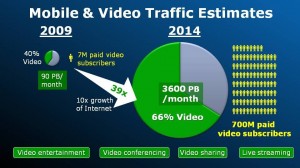
B2B Articles - Aug 15, 2012 8:51:53 PM - By Randall
Companies such as Intel, Cisco and Verizon are pouring millions into research to improve the delivery of video over our cellular and wireless networks. The first goal of the Video Aware Wireless Networks (VAWN) program is to find a good way to measure mobile video quality.
Today, smartphone owners are watching larger and larger amounts of video and network congestion threatens to ruin the experience. VAWN's first aim is to assess video quality in quantitative terms, according to execs from the three companies who recently spoke at a roundtable in San Francisco.
Viewers perceive quality differently depending on what they're watching - sports versus news, for example - quality isn't about throughput but experience, explained Jeff Foerster, principal engineer and wireless researcher at Intel Labs. That's why VAWN researchers partnered with several university's psychology departments to understand how the brain comprehends different kinds of video on various devices.
 The research is important to finding ways to deliver the best video experience to the most people when the networks get overloaded. That could mean adjusting the streams' algorithms so the network knows how to deal with the kinds of content and devices, as well as the impact of data compression, caching, and storage on video quality. One key is better cooperation between different parts of the network. Video is made up of packets of data, but “not all packets need to be treated the same,” Foerster said. “Some packets are more important than others to maximizing perceived video quality.”
The research is important to finding ways to deliver the best video experience to the most people when the networks get overloaded. That could mean adjusting the streams' algorithms so the network knows how to deal with the kinds of content and devices, as well as the impact of data compression, caching, and storage on video quality. One key is better cooperation between different parts of the network. Video is made up of packets of data, but “not all packets need to be treated the same,” Foerster said. “Some packets are more important than others to maximizing perceived video quality.”
Chris Neisinger, Verizon’s executive director of network planning, explained that “right now, we take video in forms that have been created for wired delivery, without care for what the [available network] bandwidth is.” The goal is to figure out “what parts of the video can I change, so that the cognitive perception is still high quality? How can we create a version of the video that’s really highly suited for delivery over wireless?”
Neisinger said cellular networks already do this on voice calls, making smart tradeoffs to make sure maximum number of users have the best experience. “We don’t have that in the video world. To make things more complicated, the measurements must vary by device: “You can’t just take the subjective score for a TV and directly apply it to mobile devices,” Foerster said.
Measuring subjective video quality is only the first step toward the larger goal of delivering high-quality video while boosting network capacity to handle the ever-increasing flood of data. In 5 years an estimated 90% of Net traffic will be video, and 66% of mobile traffic will be video. Video traffic is expected to grow 66 times based on the Cisco Visual Networking Index (VNI). “When you look at a number like 66X, we have to find more efficient ways to do that,” Verizon’s Neisinger said.
Different kinds of video have different requirements and there’s no need to treat them all the same, Foerster pointed out. Streaming video can use a long buffer but that doesn’t work in videoconferencing. Fast-action sports video needs a higher bit rate, but newscasts may be able to get away with a much lower bit rate.
Some of VAWN's approaches to solving these problems have to do with how the stream is compressed, for example. But others are about network management. In addition to the technological and perceptual aspects, these discussions also have a political element. “It starts getting into the discussion of Net Neutrality,” said Flavio Bonomi, Cisco Fellow and Vice President and Head of the Advanced Architecture and Research Organization at Cisco Systems. “When you treat different content in different ways… It’s a very difficult discussion, but it comes up when you allocated different bandwidth to different streams that might have different importance for users.”
The project is now in year two of its three-year, $1.1 million-per-year plan. By then end of the program, the VAWN team hopes to have a good method to measure perceived video quality, as well as algorithms and software tools to use that measurement to make network decisions.